Douglas-fir Tussock Moth
Orgyia pseudotsugata
Key Wildlife Value:
The Douglas-fir tussock moth creates snags and down wood by severely defoliating and causing the death of all sizes of true fir and Douglas-fir trees. It also interacts with other disturbance agents, especially bark beetles, to cause host tree mortality. By causing topkill in trees of various ages, O. pseudotsugata contributes to the formation of unique limb structures and facilitates the colonization of living tree boles by stem decay. During outbreaks, high numbers of egg masses, larvae pupae, and moths provide abundant forage for many species of birds and invertebrates. Some of the mortality associated with Douglas-fir tussock moth defoliation contributes to the formation of canopy gaps, increasing structural diversity.
Distribution in Oregon and Washington:
Found throughout both states. (See also Important Habitats and Outbreak Dynamics).
Hosts:
Primarily Douglas-fir, grand fir, and white fir, but many other trees and understory shrubs may also be defoliated during outbreaks, including pines, western hemlock, Engelmann spruce, and western larch.
Diagnosis:
In spring, only the new, current-year foliage is affected, appearing chewed, shriveled, and brown, and small hairy larvae may be found feeding on the foliage.

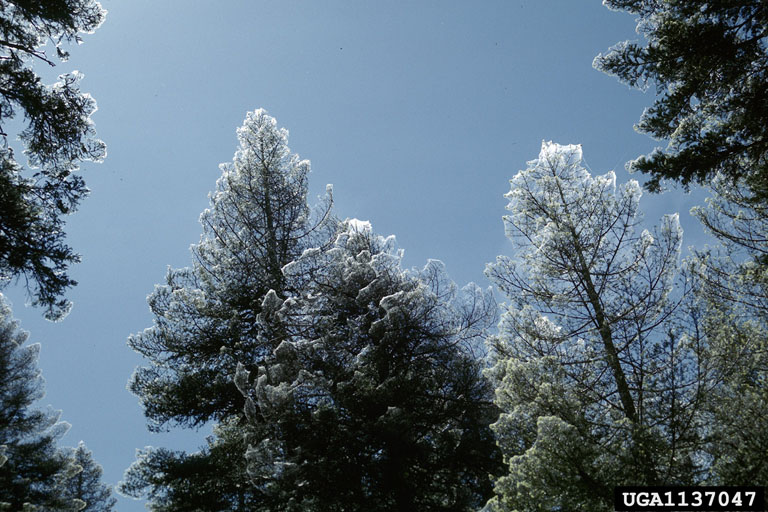
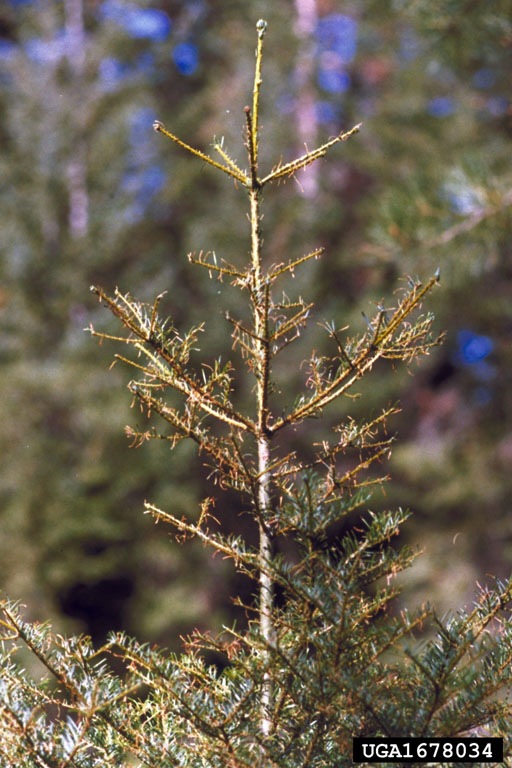
Newly hatched larvae have dark bodies covered by long, fine, light-colored, body hairs and are about 3 to 6 mm (1/8 to 1/4 in) long.
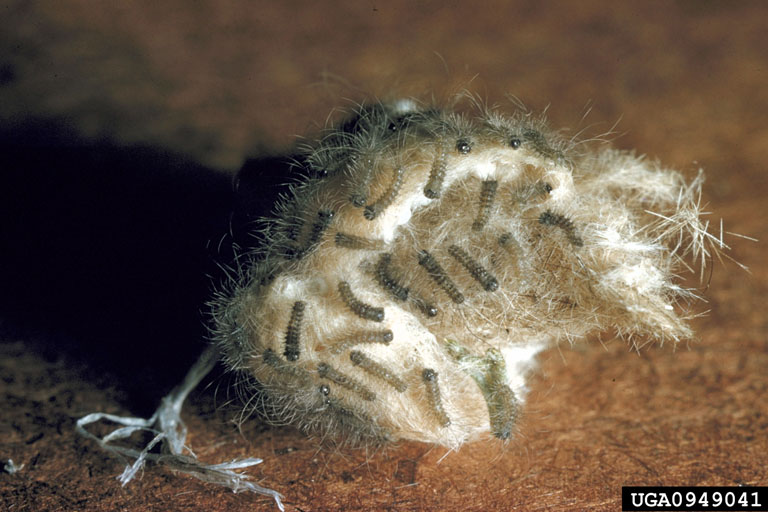
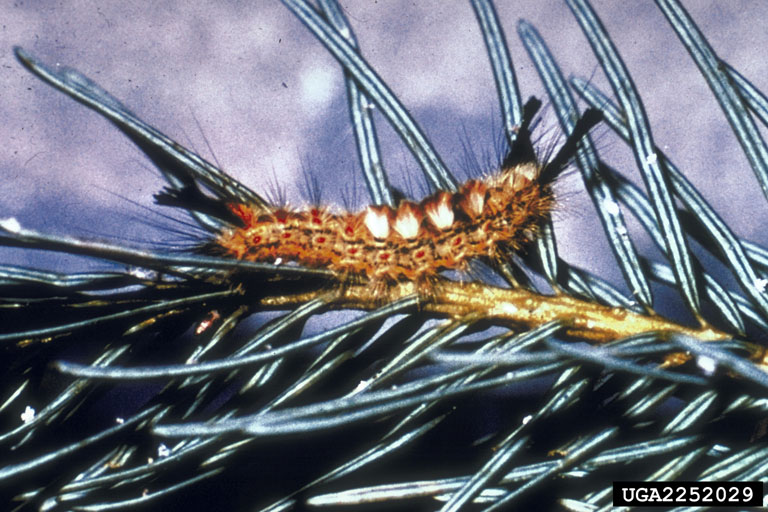
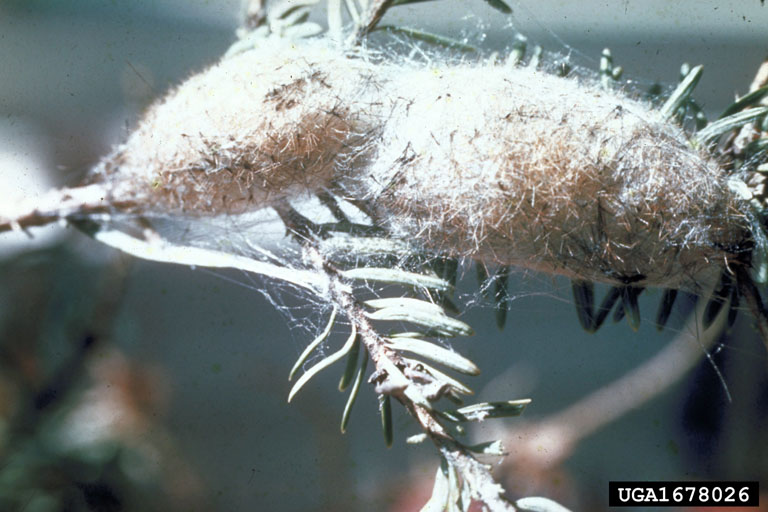

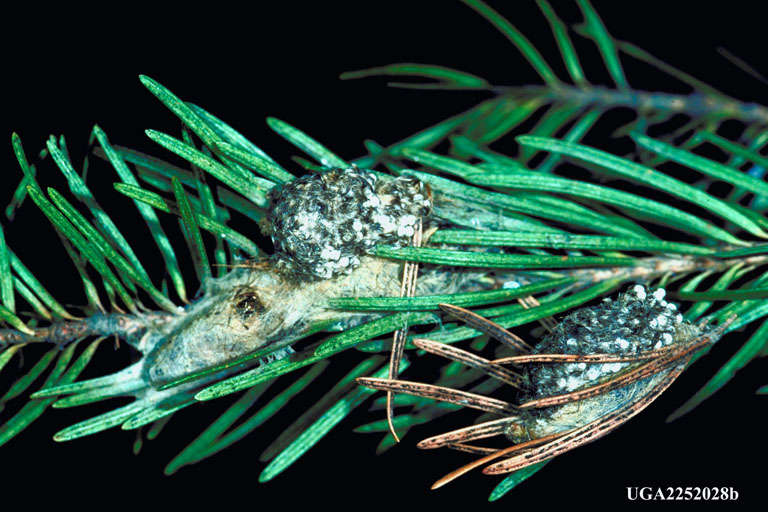
Life History:
Douglas-fir tussock moth has one generation per year. There are four life stages: egg, larva, pupa, and adult. Larvae pass through four to six developmental stages, called “instars”, and adults are small moths. The flightless adult females produce pheromones that attract males for mating. They produce a single egg mass that consists of up to 350 eggs encased in a hard frothy substance, deposited on the surface of their old cocoons during August and September. The eggs overwinter, and egg-hatch occurs the following spring in late May or early June. After hatching, the larvae crawl to new needles, being especially attracted by light to areas toward the tops of the trees, and begin feeding on the undersurfaces. They require new foliage for survival until they are about half grown, when they are able to complete development on older foliage if new foliage is unavailable. Young larvae sometimes drift short distances in air currents. It is during this phase of development that accumulations of silk, produced from the mouths of young larvae as they are disturbed by wind or drop from foliage near the tops of trees, may form ephemeral tent-like structures that cover the terminals of infested trees. Older larvae are messy feeders, chewing foliage without consuming entire needles. Pupation occurs on host foliage in late July through August inside thin, brown hairy cocoons and lasts from 10 to 18 days. Male flight occurs during afternoon and evening daylight hours, peaking in late afternoon. Adults die soon after mating and laying eggs.
The hairs of Douglas-fir tussock moth larvae and moths can cause an allergic reaction called tussockosis in people, pets, and other animals.
Important Habitats and Outbreak Dynamics:
Most Douglas-fir tussock moth outbreaks occur east of the Cascade Mountains crest in mixed conifer stands having high proportions of Douglas-fir, grand fir, or white fir. In northern Washington, Douglas-fir is the preferred host, while elsewhere in Washington and Oregon, Douglas-fir, white fir, and grand fir are equally preferred. The Douglas-fir tussock moth is always present at low levels in stands containing host tree species, and generally outbreaks occur most frequently in areas that have previously experienced outbreaks. Stands where outbreaks occur usually are densely stocked, and dominated by mature Douglas-fir, grand fir, or white fir in various proportions. Stands most susceptible to Douglas-fir tussock moth damage grow on warm, dry sites, such as ridge tops and areas that were occupied historically by pine. Douglas-fir tussock moth defoliation is frequently noted on blue spruce and other ornamentals growing in urban settings a year or two before outbreaks in natural forested areas occur.
Outbreaks develop “in place,” because dispersal is fairly limited. Females are flightless and must deposit all of their eggs near their place of origin. Dispersal is usually limited to the larval stage, when young larvae are picked up and carried by air currents for distances of usually no more than 500 m. Dispersal also occurs vertically within trees and canopy layers as larvae crawl about in search of food and drop from feeding sites. Douglas-fir tussock moth populations rise and fall in a synchronous and fairly predictable pattern, peaking every 8 to 9 years, and then declining over the next year or two to extremely low levels. For reasons not completely understood, outbreaks do not occur during every period of population increase. When an outbreak does occur, it usually lasts 3 to 4 years, going through well-defined phases of pre-release, release, peak, and decline. Outbreaks in Washington and Oregon usually collapse due to rapid spread of disease caused by a lethal nuclear polyhedrosis virus that is specific to the Douglas-fir tussock moth.
During outbreaks, Douglas-fir tussock moth generally acts as a thinning agent that favors the growth of pines and other non-host species by killing and temporarily suppressing the growth of host trees while considerable amounts of foliar nutrients are recycled to the forest floor by larvae. However, host type conversion from shade tolerant to shade intolerant species does not occur without subsequent fire or human intervention. Tussock moth outbreaks influence stand structure by causing decreased tree growth, top kill, and tree mortality. Tree density and cover may be significantly reduced in heavily defoliated stands, and small patches of 100 percent mortality may occur. Patches of severe mortality typically cover about 15 percent of an outbreak area. Trees weakened by defoliation are often subsequently killed by Douglas-fir bark beetle or fir engraver. Because Douglas-fir tussock moth defoliates both new and old foliage trees may die fairly rapidly, following only a single year of severe defoliation. Most of the mortality caused by Douglas-fir beetle and secondary bark beetles occurs in severely defoliated trees stripped of 90 percent or more of their foliage.
Because of the eruptive nature of Douglas-fir tussock moth outbreaks and high potential for significant adverse effects, accurate prediction of outbreaks is highly desirable so that suppression, if necessary, may be initiated before significant damage to stands occurs. Generally land managers do not recognize the potential for resource damage during a Douglas-fir tussock moth outbreak until the first year of complete defoliation occurs, when it is too late to implement any management options. An extensive monitoring system based on pheromone trap catches of male moths was established in 1979 throughout susceptible Oregon, Washington, Idaho, and California forests. As part of this system, called the “Douglas-fir Tussock Moth Early Warning System” (EWS), a network of traps is set out annually in an effort to predict imminent Douglas-fir tussock moth outbreaks. While the EWS successfully predicts rapid population increases two to three years in advance for large generalized areas (e.g. Wallowa-Whitman and Malheur National Forests), it does not predict whether tussock moth population levels will become high enough to cause severe defoliation before subsiding again, nor does it predict the specific locations of where high populations are likely to cause severe defoliation. However, population levels in specific areas can be predicted up to nine months in advance by using more intensive population monitoring methods such as egg mass and larval sampling. Areas for which protective measures may be needed must be identified and carefully monitored during outbreaks to detect tussock moth population increases early enough to take suppressive action before damage occurs.
Opportunities for Manipulation to Increase Wildlife Habitat:
There is little opportunity for manipulation of Douglas-fir tussock moth to increase wildlife habitat.
Potential Adverse Effects:
Douglas-fir tussock moth outbreaks cause growth loss, topkill and tree mortality, and may reduce tree density and cover to undesirable levels. Losses of existing cover may degrade the quality of habitat available for some wildlife species such as the northern spotted owl, and associated fuel accumulations may increase the risk of high-severity ground fire. Topkill and mortality caused by Douglas-fir tussock moth may cause detrimental effects to aesthetic values and public safety in recreation and other developed areas.
High populations of Douglas-fir tussock moth in the vicinities of recreation, administrative, and forest work sites may cause allergic reactions in people, pets, and other animals that are exposed.
How to Minimize the Risk of Adverse Effects:
Risk of adverse effects may be minimized by promoting thrifty stands through stocking regulation, and by encouraging the growth of non-host species. Stands comprised of less than 30 percent Douglas-fir, white fir, and grand fir are considered to have low susceptibility to Douglas-fir tussock moth outbreaks. Non-host tree species may be favored during regeneration, thinning, and selective harvest activities.
In areas having a history of Douglas-fir tussock moth outbreaks, use the Douglas-fir Tussock Moth Early Warning System for early detection of impending outbreaks. This system, which monitors Douglas-fir tussock moth populations on an annual basis using pheromone-baited sticky traps, allows time to conduct analyses and prepare for any suppression activities.
Two microbial agents may be used to suppress Douglas-fir tussock moth populations and minimize foliage loss. The first is a nuclear polyhedrosis virus specific to Douglas-fir tussock moth. It is used to induce an epizootic in increasing populations before they cause appreciable damage. The second, Bacillus thuringiensis var. kurstaki (Btk) is specific to lepidopteran larvae. It may also affect other lepidopteran larvae that ingest it, so careful consideration during planning and treatment should be given to minimize non-target effects. These insecticides are most appropriately applied to well-defined, high-value areas and not over broad landscapes.
References
Beckwith, R.C. 1978. Larval instars of the Douglas-fir tussock moth. USDA Forest Service, Combined Forest Pest Research and Development Program, Washington, D.C. Ag. Hndbk. 536. 15 pp.
Brookes, M.H., R.W. Stark, and R.W. Campbell, eds. 1978. Douglas-fir tussock moth: a synthesis. USDA Forest Service, Science and Education Agency, Washington, D.C. Tech. Bull. 1585. 321 pp.
Ferrell, George T. 1986.Fir engraver. Forest Insect & Disease Leaflet 13 (revised). USDA Forest Service, Washington, D.C. 8 p.
Goheen, E.M. and E.A. Willhite. 2006. Field guide to common diseases and insect pests of Oregon and Washington conifers. USDA Forest Service, Pacific Northwest Region, Portland, OR. R6-NR-FID-PR-01-06. 335 pp. http://www.biodiversitylibrary.org/bibliography/80321#/summary
Mason, R.R. 1996. Dynamic behavior of Douglas-fir tussock moth populations in the Pacific Northwest. Forest Sci. 42(2):182-191.
Swetnam, T.W. B.E. Wickman, H.G. Paul, and C.H. Baisan. 1995. Historical patterns of western spruce budworm and Douglas-fir tussock moth outbreaks in the Northern Blue Mountains, Oregon since A.D. 1700. USDA Forest Service, Pacific Northwest Res. Sta., Portland, OR. Research Paper PNW-RP-484. 27 pp.
Wickman, B.E. 1978. Tree mortality and top-kill related to defoliation by the Douglas-fir tussock moth in the Blue Mountains outbreak. USDA Forest Service, Pacific Northwest Forest and Range Exp. Sta., Portland, OR. Research Paper PNW-233. 47 pp.
Website links
Western Forest Insects and Diseases: Publications and Links
Forest Insect and Disease Leaflets - Douglas-fir Tussock Moth